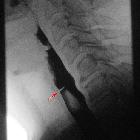Plummer-Vinson-Syndrom


Plummer-Vinson syndrome, also known as the Paterson-Brown Kelly syndrome, is a very rare condition which comprises a classic triad of dysphagia, iron-deficiency anemia and upper esophageal webs.
Epidemiology
The incidence of Plummer-Vinson syndrome has plummeted in the past fifty years and this is probably linked to the increasing rarity of significant iron deficiency anemia, although the definite cause remains unknown . A series of 1000 patients who underwent cineradiography of their hypopharynx and cervical esophagus failed to identify a single case of Plummer-Vinson syndrome .
The condition is most common in Caucasian women, typically in the 30s to 60s age group .
Clinical presentation
Three classic features :
The dysphagia is usually painless, to solids only and may be episodic or continuous.
Other features are often associated :
- glossitis
- angular cheilitis
- koilonychia
Goiter and splenomegaly may also be seen.
There is an increased predisposition to hypopharyngeal and upper esophageal squamous cell carcinoma.
Pathology
The pathogenesis of the condition remains unknown however it seems to be linked to the iron deficiency anemia .
Radiographic features
Fluoroscopy
The key imaging abnormality is esophageal webs, best seen on videofluoroscopy, although may also be seen on a barium swallow examination . Webs tend to be thin and even with a central/eccentric lumen. They are usually in the proximal esophagus. Upper GI endoscopy may also diagnose webs but can unintentionally rupture them.
History and etymology
The classic clinical manifestations of this syndrome were first described -independently - by the British ENT surgeons Adam Brown Kelly (1865–1941) and Donald Ross Paterson (1863–1939) in 1919. Paterson's description was the most comprehensive although he did not mention the anemia. The association between the syndrome and a postcricoid carcinoma was first identified by Paterson. Brown Kelly mentioned all the classic features including the anemia.
Henry Stanley Plummer (1874–1936) and Porter Paisley Vinson (1890–1959) were physicians at the Mayo Clinic in Rochester, Minnesota. Vinson described his first case in 1919, with a fuller description of the condition in a case series in 1922, although omitted mention of glossitis . In his 1919 paper he cited an earlier paper from 1912 in which Plummer had reported on a case series characterized by esophageal dilatation and dysphagia. However there is no evidence that any of Plummer's patients had this syndrome nor that he ever published on it .
Plummer-Vinson syndrome is therefore a classic example of Stigler's law of eponymy.
Siehe auch:
- Membranstenose Ösophagus
- zervikales Ösophagusweb
- Web-Stenose
- squamous cell carcinoma of the hypopharynx
- hypopharyngeal webs
und weiter:


 Assoziationen und Differentialdiagnosen zu
Assoziationen und Differentialdiagnosen zu 

